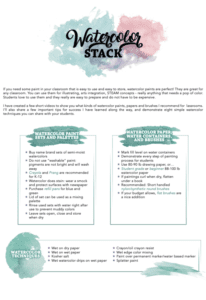8 Basic Watercolor Techniques
Watercolor can be a great medium to explore with arts integration and STEAM in the classroom. There are connections with science, literacy, and even math. In this sample video, our artist in residence Amy Traggianese shares 8 basic watercolor techniques that work well for classroom integration.
This workshop is part of our Basic Watercolor Techniques Pack in the Accelerator Professional Membership.
Applications for these Watercolor Techniques

Watercolor techniques are a versatile and fun way to engage your students within the classroom. It doesn’t matter if you’re using liquid watercolors or the typical pans used in school, the possibilities are endless. Here are some ideas for ways to incorporate the watercolor techniques shared in this sample session:
Science
Study animals in their natural habitats. Create their habitat using at least two of the techniques listed above. For instance, the hard shell of the sea turtle can be created using the salt technique. The ocean can be create with the watercolor wash. Describe the differences in texture and how they blend or do not blend into the environment.
Language Arts
Writing using texture and descriptive imagery is difficult. Make it a little more concrete by having students imagine what their story will be about. Then they can paint it using the watercolor techniques above. Then, have them write the story while describing what each character or background looks and feels like. The writing is much deeper and meaningful using these watercolor techniques.
Math
Have students make their own “custom color” by mixing paint colors and using water to lighten or deepen the shade. When the students mix their colors using this watercolor technique, they must record the ratios of paint to water they are using so that they can know their “secret formula”. Students can then create a 4×4 square of their custom color and the secret formula is written on the back. Create a class quilt of custom color squares and review the formulas and ratios on the back.





